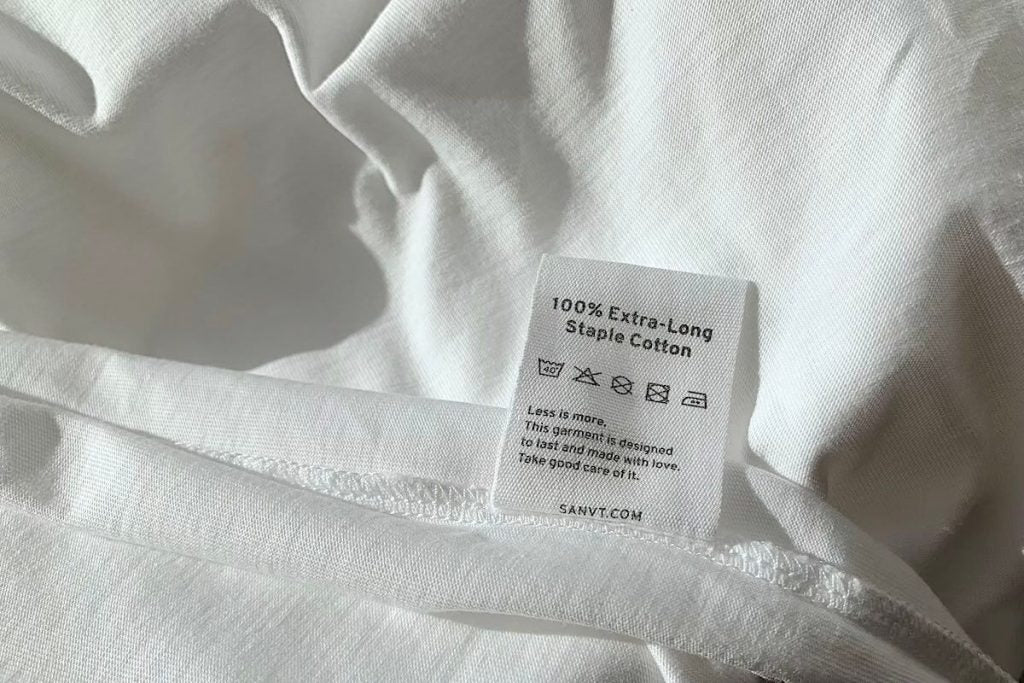Summer’s here, it’s time for the classic T-shirt to reappear after many months in second place to sweatshirts and shirts. But, while the T-shirt is the obvious garment to select from the wardrobe on sunny days, not all Tees are equally suited to summer comfort. Put on a heavyweight tee in a non-breathable fabric and you’re going to suffer!
First, here’s an overview of what you should look for when choosing the best summer fabric for a T-shirt:
- Natural: biodegradable and non-irritating on the skin (hypoallergenic)
- Lightweight: easy and graceful to move around in
- Breathable: circulating air to keep the body cool
- Soft: comfortable to wear in the heat, and gentle on the skin
- Absorbent: taking sweat and moisture away
- Odourless: the best summer fabrics don’t encourage smells and sweatiness!
But what fabrics make for the optimal mix of these factors?
Cotton – the perfect raw material for summer fabrics
Cotton is a great go-to in summer – it ticks all of the boxes for a comfortable summer fabric. It’s harvested from plants, so it’s natural; it’s typically lightweight and breathable, it’s absorbent, and it can also be super soft. Because of these qualities, it’s also odourless. In short, it’s a great summer all-rounder!
Not all cottons are equally suited to the heat though: pick a low-quality cotton, like Highland cotton, and these benefits won’t be as noticeable. To get the best from the fabric, you should select a high-quality cotton like SUPIMA or ELS cotton (used in SANVT’s lightweight summer T-shirt, alongside Lyocell). While you might pay a bit more, you won’t regret it in the heat!
Cotton knits to consider
While cotton is the raw material – it then gets spun into a yarn (below), which is then either knitted or woven into the T-shirt fabric. The photo below shows premium ELS cotton yarns, waiting to be knitted to luxury ‘jersey knit’ in the SANVT factory in Portugal…

There are three types of cotton knit that work well in hot weather:
- Jersey knit: commonly used to create T-shirts, offering a good mix of flexibility and breathability
- Pique: often used in Polo shirts. Known to be very breathable and to show less sweat compared to other types of knit (makes sense for more formal summer outings)
- French Terry: naturally breathable and absorbs moisture well, but used a bit more in sweatshirts and shorts. For more, see our other blog post on French Terry
Bear in mind that cotton knits can be pure cotton but they can also be spun into a mixed yarn with other fabrics. And in summer, it’s best to avoid mixes that include synthetics like Polyester even though they can provide extra flexibility (more on this later).
Cotton in a blend with Lyocell
Lyocell is an innovative new fabric that has gained popularity in recent years. It’s made from processed wood pulp – specifically from the regenerated cellulose fibre that emerges from the pulp after processing.
Sustainability is a big reason that Lyocell has increased in popularity because the processing uses closed-loop systems and results in minimal impact on the environment compared to other fabrics. But there are other big benefits to the wearer too, especially in summer. This is because Lyocell is lightweight but non-transparent, extremely breathable, exceptionally soft and cooling, and all this while remaining durable.
It’s the perfect material for a T-shirt that’s designed for hotter weather and It works very well in a blend with cotton. That’s why we use it in our lightweight summer T-shirt, which is crafted from an optimal cotton / lyocell mix.
More fabrics that suit summer
Another great choice for hotter weather is Linen. Like cotton, Linen is a natural fabric that’s made from the Linum plant. The qualities of Linen shine in the summer. The loose, flowing fit and exceptional breathability are kind on the skin. Linen also feels cool to the touch, due to the way it conducts heat away.
Because of these qualities, Linen is a summer-holiday staple. But, there are a few disadvantages too: the main ones being the easy wrinkling, tendency to stain, and lack of flexibility.
Chambray is another fabric that works well. It is lightweight, breathable and absorbent. Chambray is a good alternative to heavier denim, which it resembles, although this is also a disadvantage as the ‘chambray look’ isn’t so versatile.
What about fabrics to be avoided in summer and in the heat?
If you want to stay comfortable and fresh in the hotter weather then synthetic fabrics are to be avoided, as a rule. These man-made fabrics, like Polyester, aren’t very breathable and can also irritate the skin – even at the coolest of times. And remember that synthetics aren’t biodegradable so they can damage the environment.
Heavier cotton fabrics such as Denim might look the part but they’re typically too heavy to offer summer comfort. Summer also isn’t the time for Stretch Denim to be making an appearance because the synthetics used to achieve the ‘stretch’ lead to even less breathability.
Conclusion
For the best summer fabric for clothing and Tees, it’s hard to beat high-quality cotton as the best all-rounder. But, as we said earlier, remember that cotton is a fabric that runs a range of high and low-qualities depending on the variety of cotton used.
So, make sure you choose a garment made from high-quality cotton, that avoids synthetic blends. That way, you’ll be in superb shape for summer!
And if you’re looking for a lightweight T-shirt for hotter weather, we highly recommend a tee made from a cotton / lyocell blend.
If you’re looking for even more information on the best summer T-shirts, you can take a look at the other articles in the series.
- What makes the best Summer T-shirts: Part 2: Colors
- What makes the best Summer T-shirts: Part 3: Shapes



